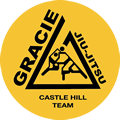By Jerry Tsui
The first six months of training in Brazilian Jiu-Jitsu can be both rewarding and frustrating. The rewarding aspects of training include getting fit, meeting new people, and learning a new skill and art. The frustrating parts of the early stages of training include being overwhelmed with information, not getting a complete grasp of the fundamentals, issues with conditioning and an inability to execute what you drilled in live rolling situations. If you have felt this way during the early part of your BJJ journey, then that means you are completely normal. Training in BJJ is a very slow grind with many plateaus, especially when you are first starting out. Here are 5 quick ways to measure your progress during the early months of your training so you can gauge your slow and steady progress.

Image: Jiu-Jitsu Times
Being able to complete all of the warm-up exercises: This is actually a big accomplishment for many people who aren’t natural athletes or weren’t regularly exercising prior to starting BJJ. Warm-ups at BJJ academies can range from 5 to 20 minutes and include jogging, stretching, body weight exercises, and agility drills. This can be overwhelming for new students who are learning new exercises like gator walks, army crawls, bear crawls, shrimping, and technical stand ups while trying to catch their breath and not wanting to look slow or silly in front of their training partners. Once you can get through all of the warm up exercises, you can challenge yourself by continually refining your form and trying to complete the exercises at a faster pace to improve your conditioning.
Executing techniques drilled in class while rolling: Live rolling in class can be very intimidating for a new white belt. Your playbook is limited and you are going to find yourself playing defense from bad positions including mount and back control. After several weeks, your gas tank and comfort level will improve. Relax and realize it is just training and fun. Try to setup and execute what you drilled in class. It doesn’t have to be a spectacular submission. It can be as simple as recovering half-guard from being mounted or correctly defending against choke. As long as the movements are technical and based on the instruction you received in class, it is all progress.
Getting submitted fewer times by mat bully: At many gyms, there is a student that eats white belts for breakfast, lunch, and dinner. During a five-minute roll, this student will mercilessly tap you ten times and leave you gasping for air and lying in a pool of your own sweat. Over time, the number of times this mat bully will tap you will go down to nine, then eight and so on. Did the bully develop a heart and go easy on you? Nope, your defense just improved.
Attending one additional class: You started with two to three classes per week. After each class, you were tired, sore, and wondering what you got yourself into. It took at least a day or two to recover from your workouts before you could get back on the mats. Over time, your body got stronger from the training and your passion has grown. Taking on one additional class is a 25% to 50% increase in your training capacity. That is a major improvement in both time and dedication and your skills will improve with the increase in time and effort.
Rolling one extra round during open mat: Choosing to attend an additional class is a conscious decision when you are fresh and your mind is clear. Choosing to roll an extra round when you are already drained, beat up, and have the option to relax against the mat is a very difficult mental and physical hurdle to overcome. The ability to decide to go one extra round when you first start training is a sign of both progress and toughness since you pushing pass your normal level of tolerance and testing your limits. It is a noteworthy achievement that shouldn’t be understated as you improve your cardio, become more efficient in your techniques, and build up your confidence on the mats.
Jiu-Jitsu Times – Jerry Tsui. 2016. 5 Ways For White Belts to Measure Their Progress. [ONLINE] Available at: https://www.jiujitsutimes.com/5-ways-white-belts-measure-progress/. [Accessed 14 October 2018].
